


Phonological Awareness – From Rhymes to Reading

Have you ever wondered why some children seem to pick up reading naturally while others struggle? The secret often lies in a skill called phonological awareness. Don't worry – it's not as complicated as it sounds. In fact, you’re probably already helping your child develop it without even realising.
In this article, we'll walk you through what phonological awareness is, why it matters and how it differs from similar-sounding terms like phonics. You'll also discover fun and simple ways you can help your child develop their phonological awareness skills right at home.
what-is-phonological-awareness-jump-link
What is phonological awareness?
Think of phonological awareness as your child's ability to hear, identify and play with the sounds of spoken language.
It's like having a superpower for hearing and manipulating the different parts of words – from syllable 'chunks' down to individual letter sounds.
Children who develop strong phonological awareness skills are much more likely to become confident readers. Research shows that phonological awareness, particularly phonemic awareness, is one of the strongest predictors of reading achievement.
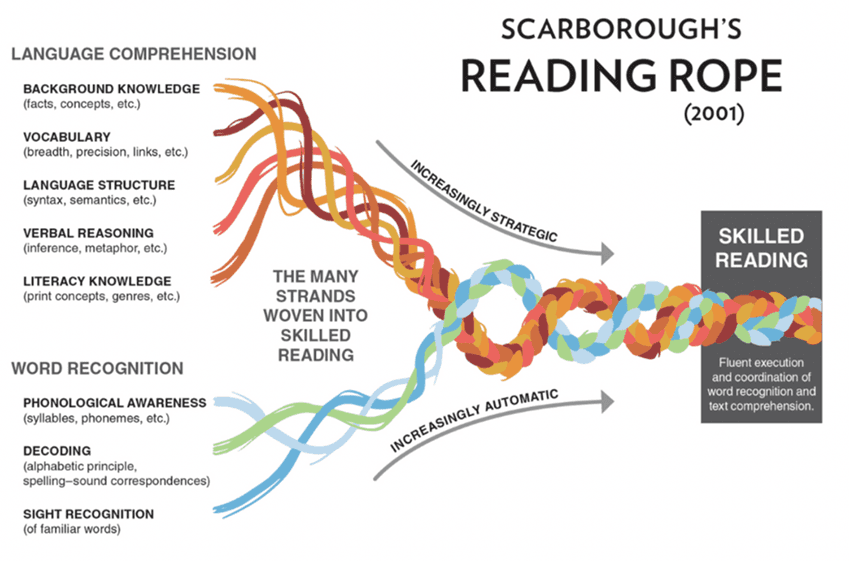
Dr. Hollis Scarborough's Reading Rope (2001) shows how multiple literacy skills weave together to create skilled reading ability.
But here's the thing that surprises many parents: early phonological awareness activities don't require letters or written words – the focus is on sounds.
Your child can develop their skills through talking, singing, and playing – long before they ever pick up a book.
By mastering these important listening skills first, learning letter sounds and phonics becomes much easier later.
Nursery rhymes that incorporate hand movements like clapping are great for building listening and phonological awareness skills in toddlers and preschoolers. Your child can sing along to fun nursery rhymes for free on the Reading Eggs Junior YouTube channel or within the kid-safe confines of the Reading Eggs Junior program. Free trial.
phonological-awareness-vs-phonemic-awareness-jump-link
Phonological awareness vs phonemic awareness
You might hear people use phonological awareness and phonemic awareness like they're the same thing, but they're more like relatives in the same family.
Phonological awareness is the big umbrella that covers all the ways we can play with sounds in spoken language. This includes:
Recognising rhyming words
Clapping out syllables in words
Hearing the rhythm in songs and poems
Breaking sentences into individual words.
Phonemic awareness sits under that umbrella as the most advanced skill. It's specifically about hearing and manipulating the smallest individual sounds (called phonemes).
For example, the word 'cat' has three separate phonemes: '/c/' '/a/' '/t/'.
Think of phonological awareness as being able to see a whole forest and phonemic awareness is like being able to focus on individual trees.
Your child develops the big picture view first, then gradually learns to zoom in on the tiny details.
The development typically flows like this:
Early skills (ages 2–4): Enjoying rhymes and songs
Building skills (ages 3–5): Clapping syllables and recognising rhymes
Advanced skills (ages 4–6): Playing with individual sounds in words.
Children are generally expected to have mastered phonemic awareness by the end of Kindergarten.
phonological-awareness-vs-phonics-jump-link
Phonological awareness vs phonics
Here's another distinction that trips up many parents: phonological awareness comes before phonics and they work in different ways.
Phonological awareness is purely about sounds we hear. No letters, no written words – just the sounds of spoken language. Your child uses their ears to:
Recognise that 'cat' and 'hat' rhyme
Clap out the syllables in 'elephant'
Hear that 'sun' starts with the '/s/' sound.
Phonics, on the other hand, is about connecting sounds to letters. It's visual and requires your child to understand that the letter 's' represents the '/s/' sound they hear at the beginning of 'sun'.
Phonological awareness is like teaching your child to hear music, while phonics teaches them to read musical notes. You need to hear the music first!
Many parents think they should start with letters and phonics. But research shows that children who develop strong phonological awareness first have a much easier time learning phonics later.
Learn more about the Science of Reading.
foundation-for-phonics-jump-link
Why phonological awareness lays a strong foundation for phonics
Imagine trying to build a house without a foundation – that's what happens when children try to learn phonics without solid phonological awareness skills.
Phonological awareness is auditory training for your child's brain.
Once children can easily hear and manipulate sounds in spoken language, they can start learning the letters that represent the sounds.
Think of it like learning to dance. First, you need to feel the rhythm and move your body to the beat. Only then can you learn the specific steps and choreography.
Phonological awareness teaches your child to feel the rhythm of language, making it natural to learn the 'dance steps' of reading later.
Research from the National Reading Panel (2000) shows that children who receive phonemic awareness instruction improve their reading and spelling abilities significantly more than those who don't. The benefits last throughout their school years – it's truly an investment in your child's future success.
Fun phonological awareness activities online!
Looking for a fun, research-backed way to support your child’s phonological and phonemic awareness skills? Reading Eggs Junior (for ages 2–4), uses songs, books and online activities to help toddlers and preschoolers tune into sounds and rhymes. Reading Eggs (for ages 3–7) guides your child through interactive lessons that build phonemic awareness, phonics and early reading skills. Start your 30-day free trial today!
The stepping stones of phonological awareness
Understanding how phonological awareness develops will help you know what to expect and how to support your child at each stage.
These abilities develop gradually and overlap – children don't need to master one skill completely before starting the next.
1. Rhyming
What it is: Recognising and producing words that sound alike at the end, like 'cat', 'hat' and 'bat'.
Why it's important: Rhyming is often the earliest indicator that a child is tuning into the sound structure of language.
Simple activities:
Read rhyming books together and emphasise the rhyming words
Play Rhyme Time during car rides: "I'm thinking of something that rhymes with 'car'..."
Sing nursery rhymes and encourage your child to fill in the rhyming words
Make up silly rhymes.
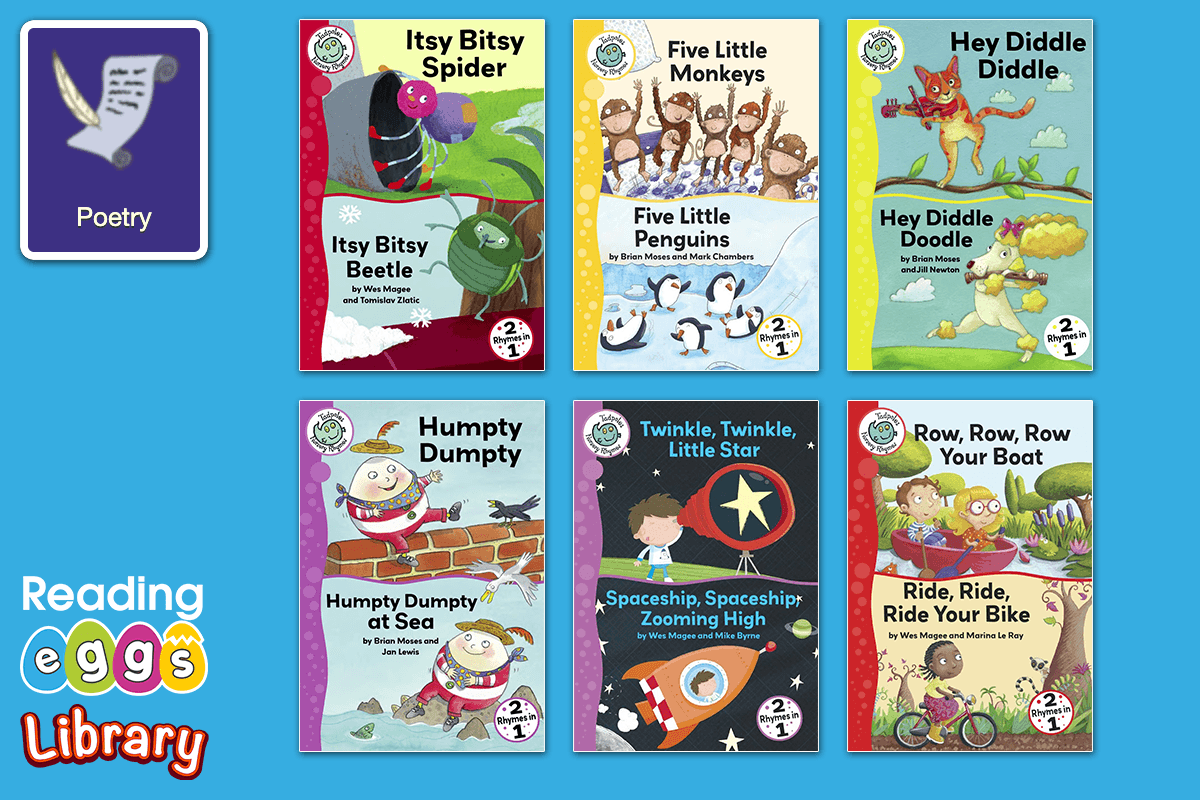
The Reading Eggs Library and Reading Eggs Junior have a range of rhyming books that you can read with your kids – from traditional Mother Goose nursery rhymes to less familiar made-up rhymes that help young children tune into the sound structure of language. Free trial
2. Alliteration
What it is: Recognising words that start with the same sound, like "beautiful blue butterflies" or "silly Sally sells seashells".
Why it's important: Alliteration helps children focus on the beginning sounds of words, which is crucial for later phonics learning. It's like training their ears to pay attention to word beginnings.
Simple activities:
Play I Spy with sounds: "I spy something that starts like 'mouse'"
Make up silly alliterative phrases and have fun with tongue twisters: "Big blue bears bounce on beds"
Read books with lots of alliteration and exaggerate the repeated sounds.
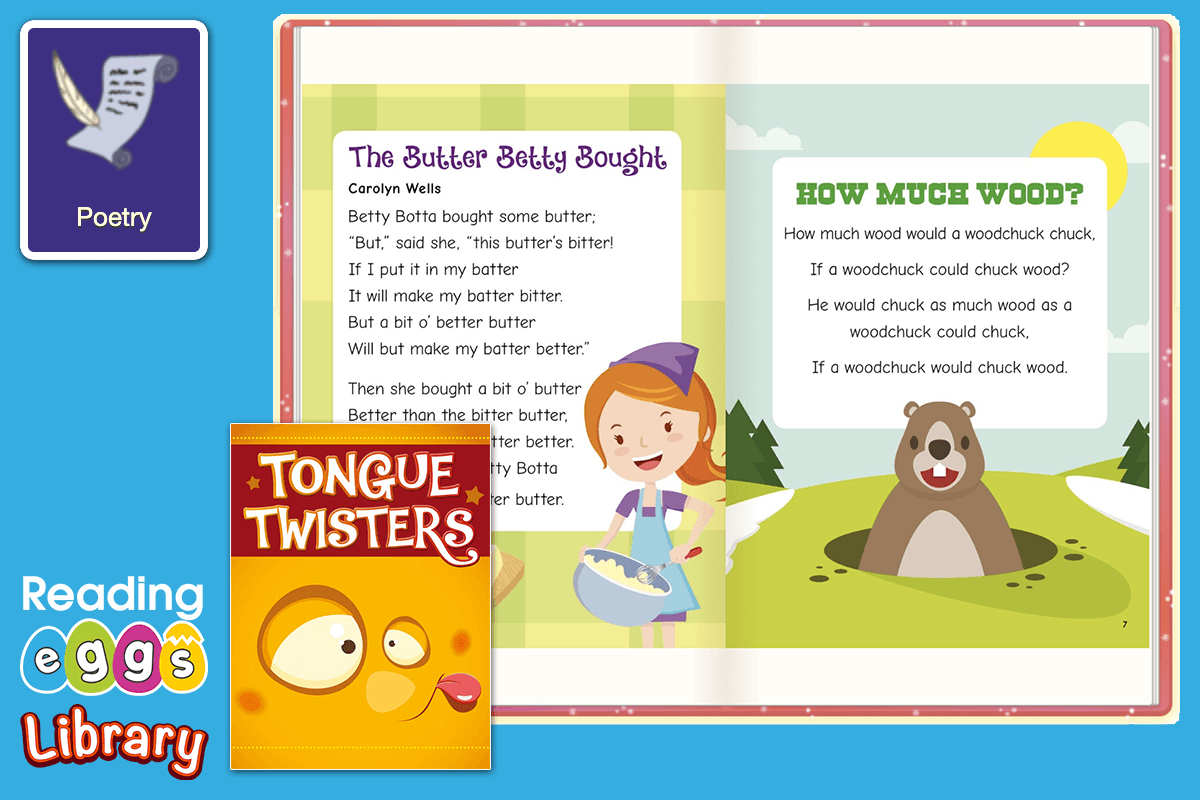
Saying tongue twisters with your child is a fun way to get them to listen attentively to spoken language. You can find tongue twisters for kids in the Reading Eggs Library. Free trial
3. Sentence segmentation
What it is: Understanding that spoken sentences are made up of individual words that can be counted and separated.
Why it's important: This skill helps children understand that language has structure. They learn that the stream of speech they hear actually contains separate meaningful units – words.
Simple activities:
Count words together using fingers or blocks: "I like dogs" – hold up three fingers
Clap for each word in a sentence
Jump or step for each word while saying short sentences.
4. Syllable segmentation and blending
What it is: Breaking words into their rhythmic parts (syllables) and putting syllable parts back together to make whole words.
Why it's important: Syllables are like the natural rhythm of language. Children who can feel this rhythm find it easier to break words into smaller parts later.
Simple activities:
Clap out syllables in family names and favourite foods
March or dance to the rhythm of different words
Play Robot Talk – say words in syllables and have your child guess the word (works best for multi-syllabic words like 'el-e-phant', 'po-ta-to', etc).
5. Onset and rime
What it is: Separating words into two parts – the initial consonant sound called the ‘onset’ and everything else called the 'rime'. For example, in 'fan', /f/ is the onset and /an/ is the rime.
Why it's important: This skill is a critical bridge between syllable awareness and full phonemic awareness. It helps children understand that words can be broken into meaningful sound chunks.
Simple activities:
Play Change the Beginning: start with 'cat' and change it to 'bat', 'hat', 'cat', 'mat', etc.
Use word family books that emphasise rime patterns
Make rhyming chains: "cap, lap, nap, sap, …what comes next?"
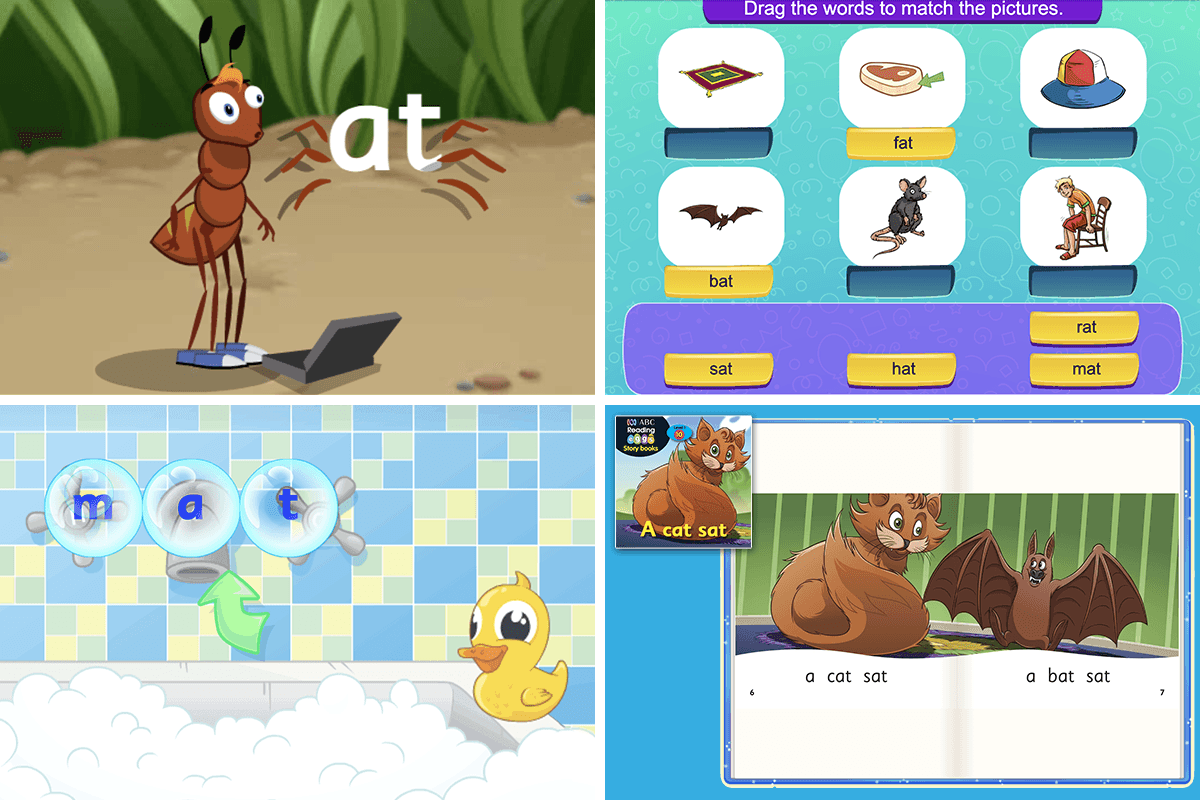
Examples of the onset and rime activities in Reading Eggs (for ages 3–7) to practise hearing and reading words with the 'at' rime. Free trial
6. Phonemic awareness
What it is: The most advanced level – identifying and manipulating the individual sounds (phonemes) in words. This is where your child learns that 'cat' has three separate sounds: '/c/' '/a/' '/t/'.
Why it's important: Phonemic awareness directly connects to decoding and spelling. When children can hear individual sounds in words, they're ready to start learning which letters represent those sounds.
What it includes:
Sound isolation: "What's the first sound in 'apple'?" (/a/)
Blending: "What word is '/c/' '/a/' '/t/'?" (cat)
Segmentation: "What sounds do you hear in dog?" ('/d/' '/o/' '/g/')
Sound manipulation: "Say 'house'. Now change the '/h/' to '/m/'. What word do you have?" (mouse).
Simple activities:
Sound Hunt – find things that start with /b/
Stretch and Say – stretch out words like rubber bands – "sss-uuu-nnn" for 'sun'
Change One Sound – start with simple words and change one sound at a time.
Read our article for more fun phonemic awareness activities.
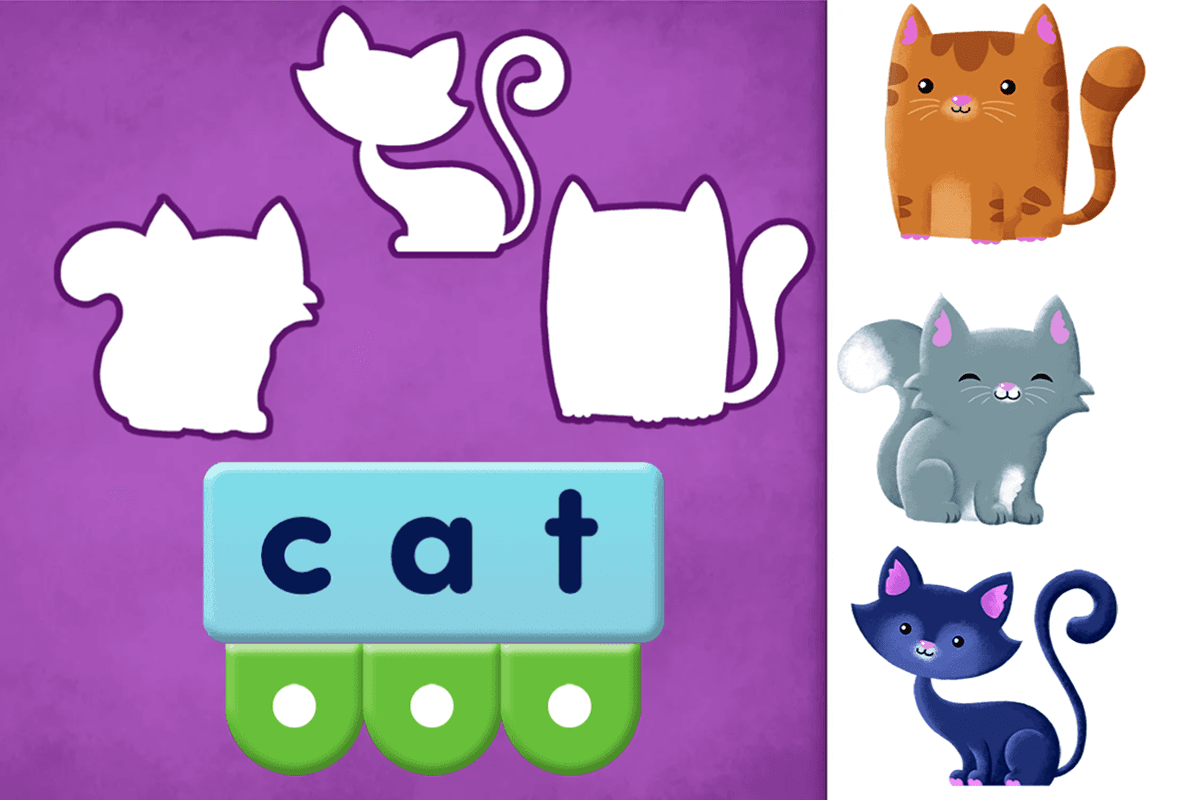
The Sound Buttons activity in Reading Eggs Junior. Free trial
developmental-journey-jump-link
General developmental journey by age
Remember, every child develops at their own pace. These age ranges are general guidelines, not strict rules. Some children will be ready earlier, others later – and that's perfectly normal!
Early foundation (ages 2–4)
Emerging skills your child might show:
Enjoying songs, rhymes and rhythmic language
Starting to recognise when words rhyme (even if they can't produce rhymes yet)
Beginning to understand that speech is made up of words.
Typical activities that help:
Singing nursery rhymes and children's songs
Reading books with repetitive, rhythmic language
Playing simple listening games
Lots of talking, storytelling and conversation.
Red flags to watch for:
No interest in songs or rhymes by age 3
Difficulty paying attention to stories or songs
Very limited speech development.
Individual variations: Some 2-year-olds love rhyming games, while others aren't interested until age 4. Both are normal!
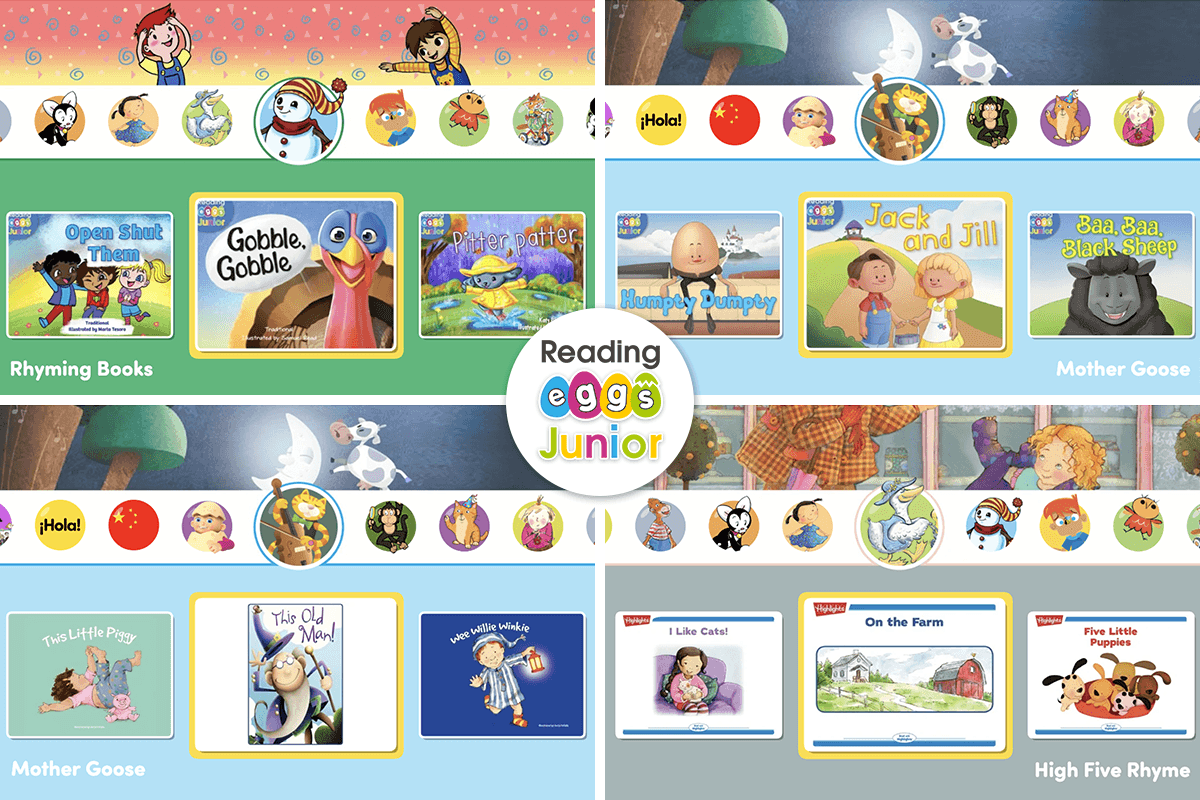
Reading Eggs Junior has an extensive range of rhyming books, nursery rhyme videos and online activities that develop phonological awareness in ages 2–4. Free trial
Preschool development (ages 4–5)
Expected skills:
Recognising and producing simple rhymes
Clapping syllables in familiar words (especially their own name)
Starting to notice beginning sounds in words
Enjoying wordplay and silly language games.
Advanced skills some children show:
Making up their own rhymes
Recognising alliteration (words that start the same)
Beginning to blend syllables into words.
Assessment indicators:
Can your child complete familiar rhymes? ("Twinkle, twinkle, little..." "Star!")
Do they notice when you make silly rhyming mistakes?
Can they clap the syllables in their name?
Activity progressions:
Move from just enjoying rhymes to actively participating, then to creating their own rhymes and wordplay.
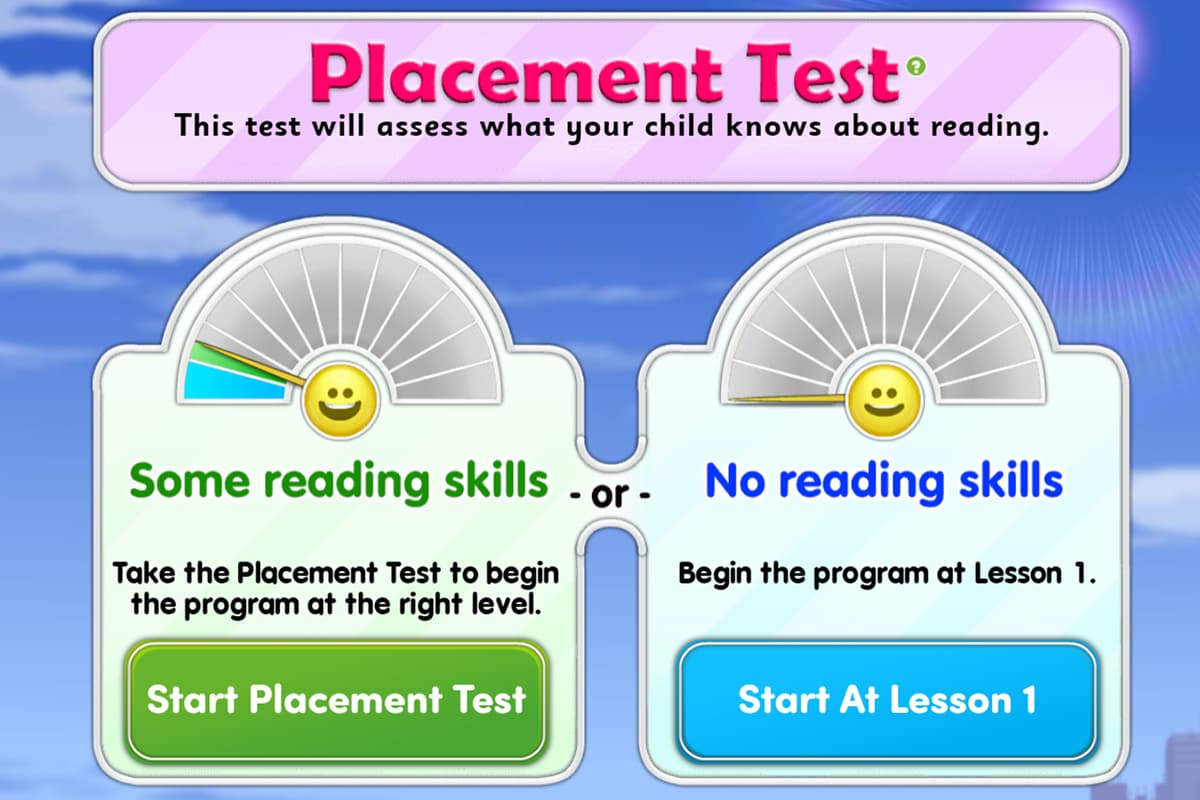
When your child is showing signs of reading readiness, have them sit the Reading Eggs placement test. This test will assess their current knowledge of letters and words and will place them at the correct lesson in the program. Free trial
Kindergarten mastery (ages 5–6)
Year-level expectations:
Consistently recognising and producing rhymes
Clapping syllables in most words
Identifying beginning sounds in words
Beginning to blend and segment sounds in simple words.
Phonemic awareness emergence:
Starting to hear individual sounds in short words
Beginning sound isolation: "What sound does 'ball' start with?"
Simple blending: '/c/' '/a/' '/t/' says 'cat'.
Children are generally expected to have mastered phonemic awareness by the end of Kindergarten.
Primary progression (ages 6–10)
Year-by-year skill refinement:
Year 1: Mastery of basic phonemic awareness (blending, segmenting 3–4 sound words)
Year 2: Advanced sound manipulation, working with longer words
Year 3 and beyond: Applying phonological skills to spelling and reading complex words.
Advanced phonemic awareness skills:
Sound substitution in the middle and end of words
Working with consonant blends and complex sounds
Manipulating sounds in longer, multi-syllabic words.
Integration with reading instruction:
Phonological awareness now works hand-in-hand with phonics and reading instruction.
Warning signs of difficulties:
Still struggling with basic rhyming in Year 1
Difficulty hearing sounds in simple 3-letter words
Continued challenges with blending sounds into words.
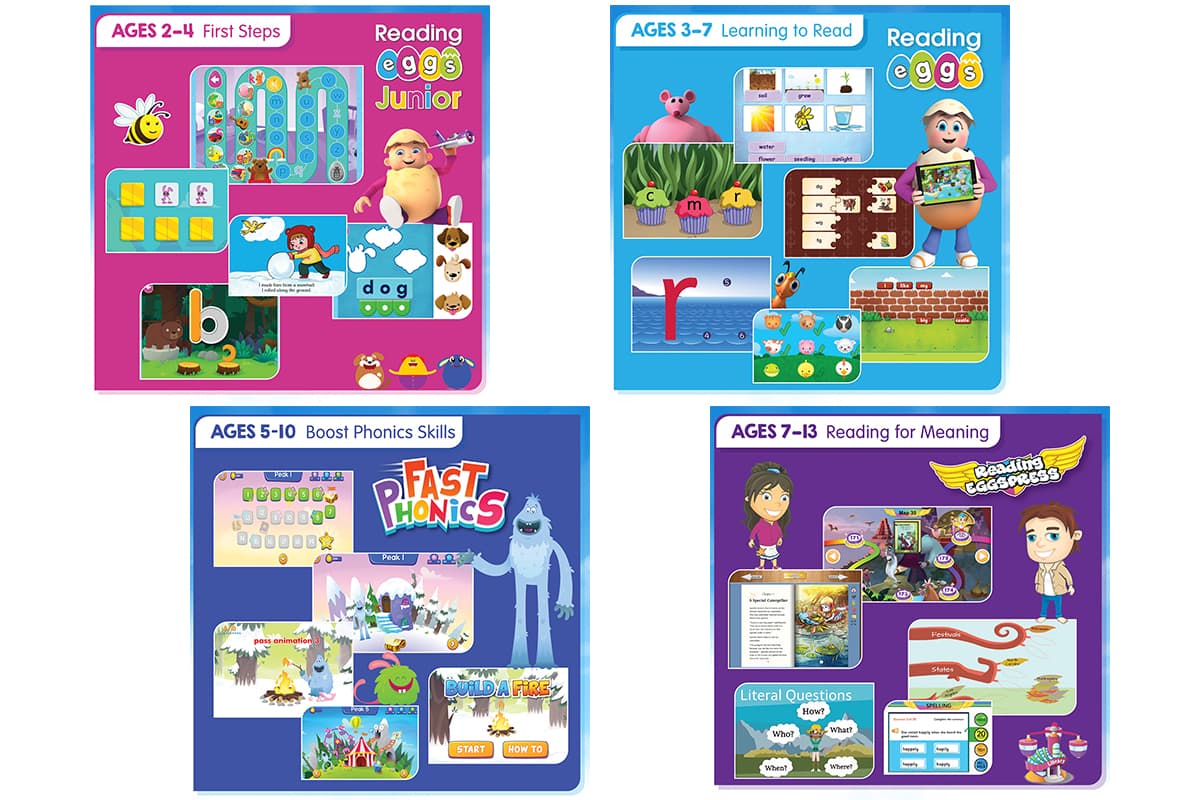
The Reading Eggs suite of programs (for ages 2–13) makes it easy and fun for children to go from phonological awareness through to mastering phonics, reading fluently and building advanced comprehension skills. Free trial
phonological-awareness-at-home-jump-link
Easy ways to foster phonological awareness at home
You don't need to be a teacher to help your child build their phonological awareness skills. You're probably already doing many things that support their development – you just might not realise it!
The foundation is simple:
Talk with your child
Sing together
Read together
Play with language.
Make it fun above all else! The activities should feel like play, not work. Stop if your child gets frustrated or bored.
Some children prefer movement-based activities, others like quiet listening games. Some love silly and absurd, others prefer realistic. Follow your child's lead.
Integrate phonological awareness into daily routines
During car rides:
Play I Spy with sounds: "I spy something that starts like 'ball'"
Find things that start with the same sound as your destination
Clap syllables for road signs and landmarks
Sing songs and [emphasize] rhyming words
Make up silly rhymes about where you're going.
At meal times:
Clap out syllables in food names: "spa-ghet-ti", "ap-ple"
Play Rhyme the Food: "What rhymes with 'rice'?"
Make up silly rhymes about what you're eating
Talk about foods that start with the same sound.
During bath time:
Sing songs with lots of repetition and rhyme
Play with the sounds of water: "splash", "drip", "bubble"
Make up rhymes about bath toys.
Before bedtime:
Sing rhyming lullabies to your child
Make up a goodnight rhyme to say when it's time for sleep.
On walks:
Point out things that start with the same sound: "Look, a big blue bus!"
Count syllables by stepping: "dan-de-li-on" (four steps)
Listen for environmental sounds and talk about them.
Signs your child might need extra support
The variation in 'normal' development in children is huge.
Some children are naturally more interested in visual or physical activities than sound-based ones. Some are perfectionists who won't attempt something until they're sure they can do it well. Some children don't show strong phonological awareness until age 6 or 7. However, with the right support, they can still achieve reading success.
As a parent, you know your child best. Trust your instincts – if something seems off, it's worth paying attention to.
Common signs a child might be struggling:
By age 4: Shows little interest in rhyming games or can't complete familiar nursery rhymes
By age 5: Can't clap syllables in their own name or simple words like ‘elephant’
By age 6: Struggles to identify beginning sounds in simple words like 'ball' or 'sun'
Any age: Seems frustrated or confused by sound-based games that other children enjoy.
Most phonological awareness difficulties can be addressed successfully with patience, practice and sometimes professional guidance.
Who to consult:
Start with your child's teacher or paediatrician. They can help you determine if a speech-language pathologist or reading specialist evaluation would be helpful.
Catch-up strategies for late developers
Try the intensive intervention approaches below for 6–12 months:
Introduce more frequent, but shorter, practice sessions
Incorporate multi-sensory activities (using movement, visual aids, tactile elements)
Break skills into smaller steps
Celebrate progress – no matter how big or small – consistently.
Fun phonological awareness activities online!
Looking for a fun, research-backed way to support your child’s phonological and phonemic awareness skills? Reading Eggs Junior (for ages 2–4), uses songs, books and online activities to help toddlers and preschoolers tune into sounds and rhymes. Reading Eggs (for ages 3–7) guides your child through interactive lessons that build phonemic awareness, phonics and early reading skills. Start your 30-day free trial today!
Conclusion
Phonological awareness truly is the secret foundation of reading success – and now you have the knowledge and tools to help your child build that foundation through everyday play and interaction.
The journey from rhymes to reading doesn't happen overnight, but with your support and these evidence-based strategies, you're giving your child an incredible gift – the foundation for a lifetime of successful reading and learning.
Key takeaways to remember:
Start where your child is – every child develops at their own pace
Keep it playful – the best learning happens through joy and laughter
Consistency matters more than perfection – a few minutes daily beats long, infrequent sessions
Trust your instincts – you know your child best and can adapt these activities to their interests
Phonological awareness comes before phonics – focus on sounds before introducing letters.






